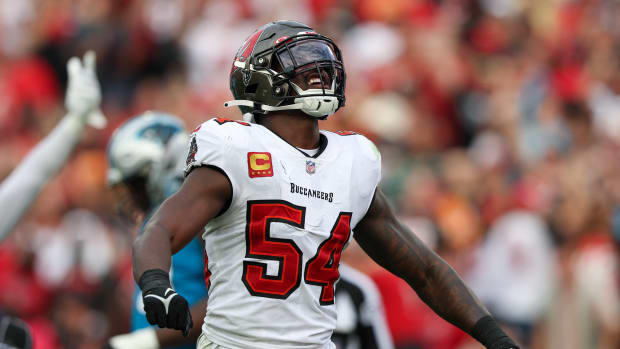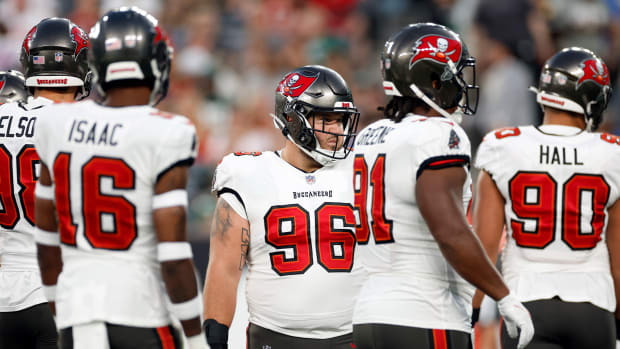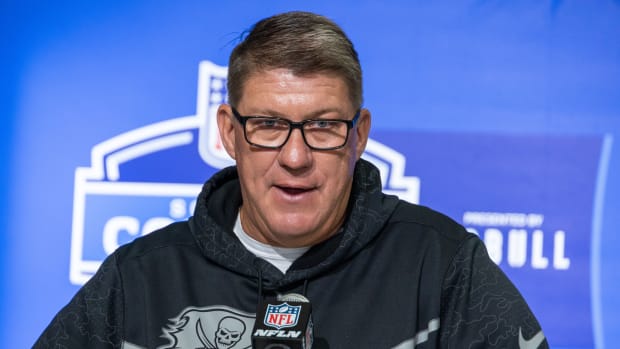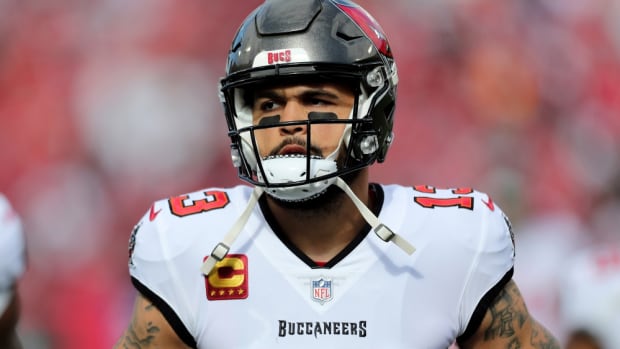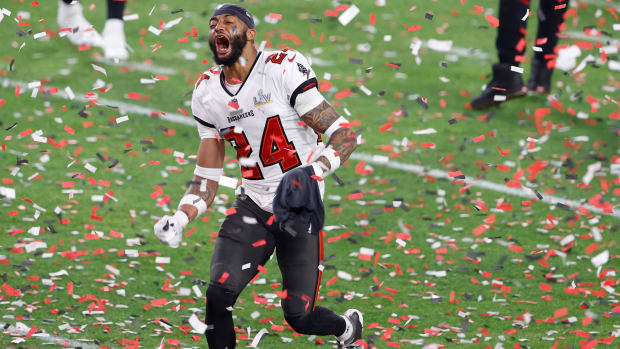What We Learned From the Buccaneers Super Bowl Title Season
The Tampa Bay Buccaneers went and did it.
Super Bowl LV champions, the Buccaneers are the seventh wild card team - entering this year's postseason as the No. 5 seed - to hoist the Lombardi Trophy in the history of the game. Finishing the 2020 season on an eight-game winning streak following an idle Week 13, the Bucs defeated four consecutive division champions en route to the big game, thanks to 30+ points in each game and nine turnovers forced by the defense.
It was an up-and-down season for Tampa Bay up until the bye week, as the Bucs started the year at 6-2 and entered Week 13 at 7-5. They wouldn't lose another game after a Week 12 drop to the Kansas City Chiefs, avenging that regular-season loss with a 31-9 triumph as the season came to a close.
In the end, the Bucs were simply dominant, on both sides of the ball as required. Here's what we can pull from their season in review as Tampa Bay looks to repeat as league champs in 2021-22.
Tom Brady proved every doubter wrong, and lifted the Buccaneers to the Promised Land
At 43 years old, following a season in which he appeared to take a step back in New England, no one was quite sure Tom Brady could take a 7-9 Buccaneers team and turn them into championship contenders.
Brady, telling anybody who asked why he came to Tampa Bay along the way that he had something to prove to himself, did just that - simultaneously proving doubters wrong. Brady earned the Super Bowl MVP honor for the fifth time in his career, and is the first quarterback to ever win that award with different teams. Peyton Manning is the only other quarterback to start a Super Bowl with two squads (Indianapolis and Denver).
Across 20 games in total, Brady would throw for 5,694 yards, 50 touchdowns, and 15 interceptions. His 40 regular-season passing touchdowns were the second-most in a single season of his career, and his 10 postseason touchdowns are the most in Buccaneers history, doubling Brad Johnson's record of five in two trips to the bracket.
On top of his impressive production, Brady instilled a championship mindset on a team that, according to Bruce Arians, weren't big believers in themselves a year ago.
“This was a very talented football team, last year. But we really didn’t know how to win and when you bring a winner in and he’s running the ship, it makes a total difference in your locker room, every time we step out on the field," Arians exclaimed on Monday. "We came from behind I think two times by 17 points down and I think the leadership that Tom brings and his attitude that, ‘Hey, let’s go play. It’s never over until it’s over and we’re going to win this thing somehow, some way.’
"It permeated through our whole locker room, his belief that we’re going to do this and knowing he’d been there and done it, our guys believed it. It changed our entire football team.”
Brady signed with a new team after 20 years in New England, aiming to demonstrate that he had enough in the tank and was capable to lift a Lombardi Trophy with a new team. He did just that.
The Buccaneers offensive line emerged as a strong unit in pass protection
Often throughout the season, Donovan Smith received some criticism for his play at left tackle as rookie Tristan Wirfs was praised for his performance on the opposite side, even as Smith dealt with and played through an ankle injury. Paired with a midseason concussion for star left guard Ali Marpet, and the Buccaneers offensive line struggled to give Brady much time to throw the ball.
That narrative, despite Marpet's return, didn't turn around until late in the postseason. Smith quietly improved following the bye week and ended up allowing one sack and six pressures over his final seven games (all offensive line stats according to Pro Football Focus), arguably playing the best ball of his career.
Ryan Jensen, displaying a mean streak against fierce defensive lines, allowed some pressure along the way but gave up just one sack in Tampa Bay's final ten games, compared to three over its first ten.
Wirfs played outstanding football all season long, looking like a veteran far more often than a rookie. He allowed one sack across 20 games and just five of his 24 pressures on the season in Tampa Bay's closing nine contests. Wirfs was on the field for each and every offensive snap of the year.
The Bucs saw mixed results from their OL depth throughout the year but may have found a gem in former undrafted free agent Aaron Stinnie. Stepping up for the injured Alex Cappa, who fractured his ankle against Washington in the Wild Card, Stinnie allowed one sack in his place and just one pressure in the Super Bowl.
The Bucs offensive line allowed Brady to be sacked an average of 1.5 times per game across the eight-game win streak, stepping up when needed most to let Brady find his passing game targets. That allowed Arians and offensive coordinator Byron Leftwich to dial-up aggressive play calls and get the Bucs off to fast starts offensively, also opening up the rushing attack as games went on - a crucial aspect of the playoff run.
Tampa Bay drastically cut down penalties from 2019
Penalties can make-or-break a game. Although the Chiefs lost the Super Bowl because it couldn't dominate offensively as they typically do, Kansas City was plagued by penalties on defense which put the Bucs in an ideal position to score throughout the game.
Meanwhile, Tampa Bay had eight penalties in the Super Bowl - with just one in the first half compared to nine by Kansas City, one of which was declined. 14 of Tampa Bay's 57 penalty yards came off of a taunting call on safety Antoine Winfield Jr. after a fourth-down pass breakup with four minutes left in the game while the Bucs held a 22-point lead.
The Bucs didn't deal with yellow flag issues all too often throughout the 2020 season, massively improving in the penalty department compared to a year ago. Tampa Bay committed just 84 penalties in 2020, giving 715 yards - down from 133 penalties for 1111 yards a year ago, according to The Football Database.
Tampa Bay ranked No. 11 in penalties this year compared to dead last in 2019, and No. 14 in yards given up via penalty compared to No. 30 last season. The Buccaneers would commit bigger penalties slightly more in 2020 (8.51 yards per penalty) than 2019 (8.35 YPP), but that ultimately did not hamper what was otherwise much cleaner football from Bruce Arians' team.
The Bucs defense improved along the way, and could get even better in 2021
Tampa Bay was crowned as the league's best rushing defense at the end of the year, giving up just 80.6 yards on the ground during the regular season.
However, especially during the midseason 1-3 stretch, Tampa struggled against up-tempo passing offenses. Patrick Mahomes, the most relevant example, torched the Bucs for 469 yards and three touchdowns in Week 12 - 203 yards and all three scores to Tyreek Hill in the first quarter alone.
The second time around, Mahomes was pressured on 52% of his dropbacks on Sunday by the Bucs pass rush which is more than any quarterback in Super Bowl history. Never able to get comfortable and forced to extend plays all night long, Mahomes would complete 53.1% of his passes for 270 yards, no touchdowns, and two interceptions in the big game.
Rattling the opposing quarterback - two will be first-ballot Hall of Famers in Drew Brees and Aaron Rodgers, and it's easy to assume Mahomes will be as well - and creating passing game turnovers became the new norm for Tampa Bay in the playoffs. Pair that with allowing just 91 rushing yards per game in the postseason, and it's clear that the Bucs defense was just as important as its offense in crunch time.
As we'll touch on in our next section, Tampa Bay's defense could get even better next year as well. The NFL's salary cap projection has reportedly increased to $181 million, which would allot the Bucs with $38.1 million to retain impending free agents such as edge rusher Shaquil Barrett and linebacker Lavonte David, among others.
The entire starting secondary played its best ball in the playoffs and remains on its rookie deals, so the arrow is pointing up on the backend. Defensive tackle Vita Vea and Devin White are on their rookie contracts too, both being focal points of the Bucs defense that will be affordable in the short term. The Buccaneers are widely expected to target a defensive player early in the 2021 NFL Draft as well, to build upon their depth.
This offseason can help the Buccaneers establish a dynasty, if it goes right
Given the latest cap projections, Tampa Bay have the seventh-most cap space of any NFL team this offseason. The Bucs also own seven draft picks, without one in the sixth round, but two in the seventh thanks to a previous trade with the Pittsburgh Steelers.
Despite 31 currently-rostered players set to become free agents, Tampa Bay can afford to retain most of their impact players whose contracts are expiring. We could see some cap casualty releases and pay cuts across the roster to ensure Barrett, David, wide receiver Chris Godwin, defensive end Ndamukong Suh, running back Leonard Fournette, tight end Rob Gronkowski, wide receiver Antonio Brown, and others can return, but those moves shouldn't hurt the Bucs in the long run.
Could Tampa Bay afford to retain its important free agents as well as sign additional free agents? That will depend on who signs and the structure of each deal, but lucrative contracts can be shaped in favor of the team's cap table as dedicated by yearly cap hits and signing bonuses. Tampa Bay could structure deals to take on bigger cap hits down the road but provide each signee with bigger bonuses, opening up some room to sign either a few depth pieces or perhaps a bigger-name free agent.
Pair that with the Buccaneers' recent draft success - general manager Jason Licht has identified five starters and numerous key depth players over the last two draft classes - and who's to say Tampa Bay can't continue to contend for Super Bowls provided the current strengths of its roster?
